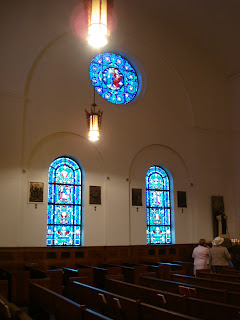For my final church visit of the year, I asked my good friend John, who’s gone with me to a bunch of different churches, to pick which church he’d like to go to. I also wanted him to do it because he’s not coming back to GW next year as a FOCUS missionary, since joining the seminary to study to become a priest next year. At any rate, he picked the 9 AM Mass at St. Martin of Tours in Northeast Washington. After trying to figure out how long it would take to take the Metro there, a trip involving several transfers and a considerable walk to the church, I suggested that we just walk the entire way from Foggy Bottom. It was about a forty minute walk up Rhode Island Avenue, and John, Loreto and I got to enjoy a beautiful day in Washington.
St. Martin of Tours is in an interesting location, situated on hill right next to a bridge going over North Capitol Street. It was hard to distinguish a single architectural style on the building, it seemed to embrace neo-classical Greek and Roman architecture. The interior of the church had mostly plain white walls, with blue stained glass windows. At the front of the church were two banners, one depicting human figures dancing, and another showing a caterpillar becoming a butterfly. At the rear of the church, below the choir loft, there were two quilts hung with African-influenced patterns. The area behind the altar had a large wooden frame and a golden cross; it had a very modern feel.
There was one cantor singing accompanied by the powerful pipe organ. The Mass was interesting because not all of the pews had kneelers, so rather than kneeling, the parish stood up. I asked Deacon Robert about this after Mass, and he said that the standing was also something the parish chose to do regardless of the missing kneelers. Father Michael gave the homily, and discussed the appearance of Jesus to the men on the road to Emmaeus. He reminded us that these fellows were leaving Jerusalem disappointed before Jesus appeared to them. While they may have given up on Christ, but Christ did not give up on them. Father said that our mothers often do the same thing in our lives, and then called the church’s mothers up to the altar for a Mother’s Day blessing. When he did, a long line of mothers formed that went all the way to the back of the church.
John, Loreto, and I went downstairs after Mass for a fundraiser for the parish youth group’s production of The Wiz. We had a nice time talking with Deacon Robert and our new friend Irene, a nursing professor at Georgetown University who supervised a service-learning project at St. Martin of Tours. It was a great way to end the semester.
Links:
St. Martin of Tours Website (The noisiest church website I've ever been on)
Pictures:
Churches I've Been To So Far:
View DC Churches I've Been To So Far in a larger map






